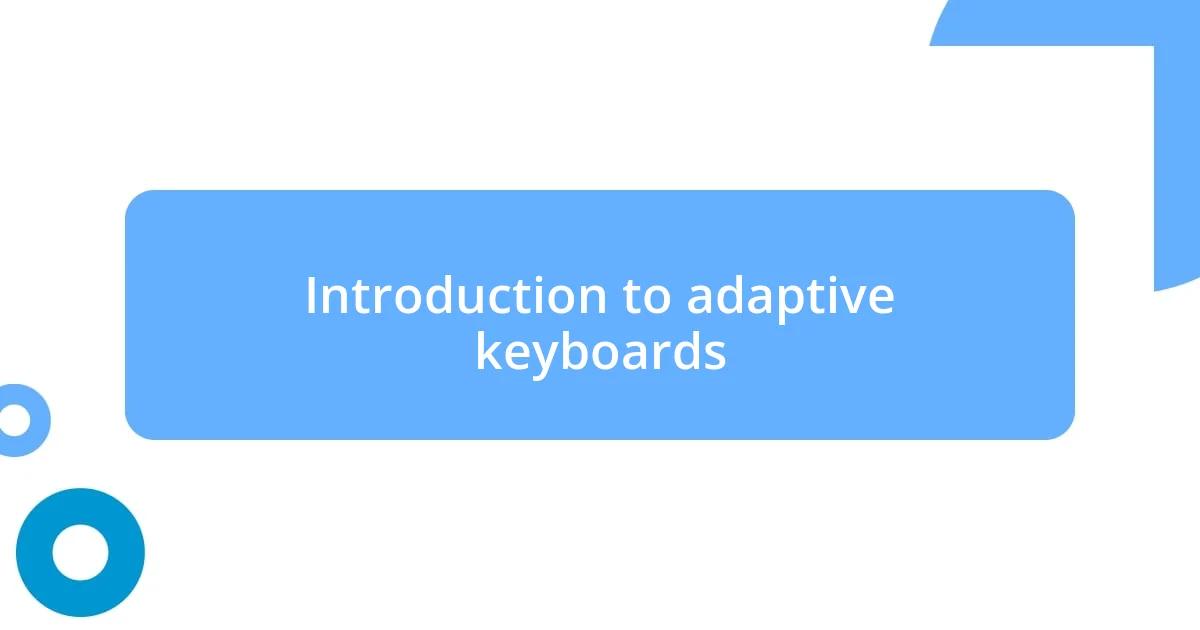Key takeaways:
- Adaptive keyboards enhance user experience through customizable features, improving productivity and comfort for various tasks.
- Different types of adaptive keyboards, including mechanical, virtual, ergonomic, and specialized options, cater to unique user needs and preferences.
- These keyboards significantly enhance accessibility for individuals with disabilities, allowing tailored input methods and configurations that foster independence and ease of use.

Introduction to adaptive keyboards
Adaptive keyboards are innovative tools designed to enhance user experience by offering customizable features tailored to individual needs. I recall my first encounter with one; it felt like stepping into a new dimension of typing. How many times have you wished your keyboard could adapt to the way you work or play?
These keyboards can change layout, key functions, and even feedback based on the user’s preferences or tasks at hand. Personally, the ability to switch between different layouts in an instant transformed my approach to various applications. Can you imagine how much more productive one could be with a keyboard that understands your habits?
There’s something exciting about the prospect of a device that can evolve with you. With each keystroke, adaptive keyboards aim to bridge the gap between technology and personal expression. Have you ever thought about how much your keyboard says about your unique style of working?

Benefits of using adaptive keyboards
Using adaptive keyboards can significantly enhance productivity and comfort. I remember a time when I was knee-deep in a project with tight deadlines; utilizing an adaptive keyboard allowed me to switch to a layout specifically for coding, making my workflow smoother and faster. The moment I realized I could customize key functions, it felt like unlocking a hidden level in a game—suddenly, tasks that used to take me forever were completed in a fraction of the time.
Here are some key benefits of using adaptive keyboards:
- Customization: Users can tailor layouts and functions to fit specific tasks, making it easier to navigate complex software.
- Ergonomics: Many adaptive keyboards come with features that support proper wrist positioning, reducing strain during long typing sessions.
- Accessibility: They can be configured to assist individuals with disabilities, providing alternative input methods for improved usability.
- Multi-functionality: Users can easily switch between different keyboard configurations, allowing fluid transitions between various types of work.
- Enhanced Feedback: Adaptive keyboards often include adjustable tactile feedback, catering to personal typing preferences—helping create a more satisfying user experience.

Types of adaptive keyboards available
Adaptive keyboards come in several varieties, each tailored to unique user needs. For example, there are mechanical adaptive keyboards that offer customizable key switches, allowing users to alter tactile feedback based on their preferences. I remember when I tried one out during a tech workshop; the satisfying click of each key was both comforting and energizing. On the other hand, virtual adaptive keyboards, which operate via touchscreen devices, provide flexibility in layout and design, adapting instantly to whatever task you’re working on. Have you ever felt the freedom of navigating through your device with just a swipe? It’s a game-changer.
Another intriguing option is the * ergonomic adaptive keyboards* designed specifically to enhance comfort and reduce strain. I once spent an entire day coding without a break, and I can’t stress enough how a well-designed ergonomic keyboard transformed that experience. Instead of feeling the fatigue creeping in, I found that my posture improved, and it felt almost liberating to type effortlessly. It’s fascinating how design can directly impact our productivity and comfort levels!
Lastly, specialized adaptive keyboards cater to specific industries, such as gaming or graphic design, featuring customizable macros and shortcuts. For instance, I frequently used a gaming keyboard with programmable keys that saved me countless clicks during marathon sessions. It’s these small tweaks that can make a massive difference in efficiency, especially when your passion demands rapid responses. With each type offering distinct advantages, the landscape of adaptive keyboards is as diverse as the users themselves.
| Type of Adaptive Keyboard | Description |
|---|---|
| Mechanical Adaptive Keyboards | Offer customizable key switches for tactile feedback. |
| Virtual Adaptive Keyboards | Touchscreen-based, allowing instant layout changes. |
| Ergonomic Adaptive Keyboards | Designed for comfort to reduce strain during usage. |
| Specialized Adaptive Keyboards | Cater to specific industries with programmable features. |

How adaptive keyboards enhance accessibility
The beauty of adaptive keyboards lies in their ability to enhance accessibility for those with differing needs. I recall a friend of mine who struggled with traditional keyboards due to a motor skill challenge. When she switched to an adaptive keyboard with larger, well-spaced keys and customizable layouts, it was like watching her find her voice in the digital world again. The difference was profound; suddenly, she was no longer frustrated but empowered to communicate and engage effortlessly.
Another incredible aspect is the ability to tailor input methods that suit individual needs. I remember attending a conference where a presenter showcased an adaptive keyboard specifically designed for individuals with visual impairments. It featured tactile markers and voice feedback, making every keystroke an interactive experience. Can you imagine navigating technology without sight, yet feeling more in control than ever? It’s a testament to how these keyboards can truly level the playing field and foster independence.
Furthermore, the multi-functionality of these keyboards can dramatically change the landscape for users with disabilities. I once experimented with a configuration that provided on-screen prompts while typing, which was invaluable during a training session. How often do we overlook the power of visual cues in our daily tasks? These small adjustments can lead to significant breakthroughs in productivity, ensuring that everyone can contribute their unique talents without barriers.














